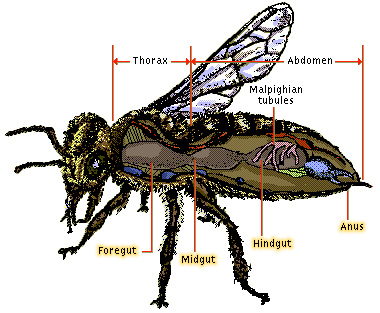 Insects have a simple extracellular digestive track running from
mouth to anus which consists
of three main sections: the foregut, the midgut,
and the hindgut. The forget can be further divided into three
parts: the gullet, the crop, and the
proventriculus. Food travels from the mouthparts
through the gullet to the crop
where it is stored for eventual digestion. Insects have salivary glands
which empty into the gullet to help digest food. Most of the actual
digestion takes place in the midgut, and the resulting nutrients are
absorbed in both the midgut and the hindgut.
Any remaining waste is then eliminated through the anus.
Insects have a simple extracellular digestive track running from
mouth to anus which consists
of three main sections: the foregut, the midgut,
and the hindgut. The forget can be further divided into three
parts: the gullet, the crop, and the
proventriculus. Food travels from the mouthparts
through the gullet to the crop
where it is stored for eventual digestion. Insects have salivary glands
which empty into the gullet to help digest food. Most of the actual
digestion takes place in the midgut, and the resulting nutrients are
absorbed in both the midgut and the hindgut.
Any remaining waste is then eliminated through the anus.
|
Special Adaptations
- Most insects have crops for storing food before digesting it.
This allows insects to survive for a longer period without eating. Ants use their
crops to carry food which they can then feed to other ants.
-
Insects have unique and varied mouthparts which allow them to
chew, suck cut, or liquefy food. Insects have mandibles which move horizontally
(from side to side) instead of vertically.
-
Some insects actually have teeth inside their digestive track
which help to grind food into small pieces.
|
Key Structures
- Malpighian tubes in the insect's hindgut
link the insect's digestive system to it's excretory system.
- Some insects, including mosquitoes and butterflies, have proboscises
for sucking food.
|
 Insects have a simple extracellular digestive track running from
mouth to anus which consists
of three main sections: the foregut, the midgut,
and the hindgut. The forget can be further divided into three
parts: the gullet, the crop, and the
proventriculus. Food travels from the mouthparts
through the gullet to the crop
where it is stored for eventual digestion. Insects have salivary glands
which empty into the gullet to help digest food. Most of the actual
digestion takes place in the midgut, and the resulting nutrients are
absorbed in both the midgut and the hindgut.
Any remaining waste is then eliminated through the anus.
Insects have a simple extracellular digestive track running from
mouth to anus which consists
of three main sections: the foregut, the midgut,
and the hindgut. The forget can be further divided into three
parts: the gullet, the crop, and the
proventriculus. Food travels from the mouthparts
through the gullet to the crop
where it is stored for eventual digestion. Insects have salivary glands
which empty into the gullet to help digest food. Most of the actual
digestion takes place in the midgut, and the resulting nutrients are
absorbed in both the midgut and the hindgut.
Any remaining waste is then eliminated through the anus.